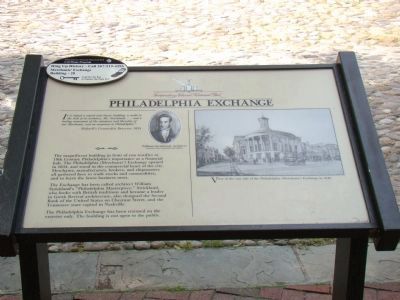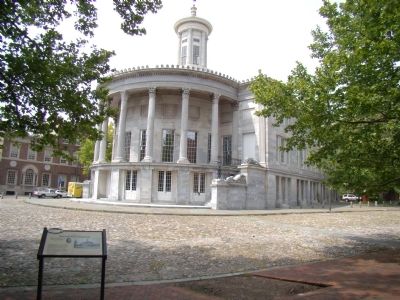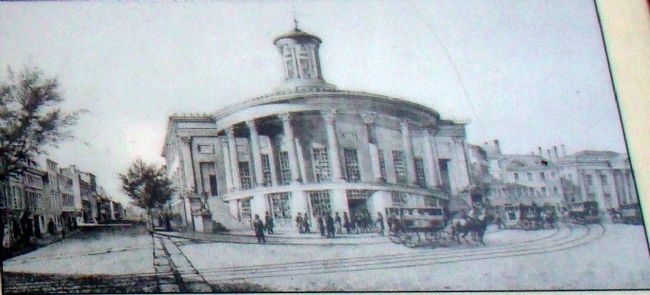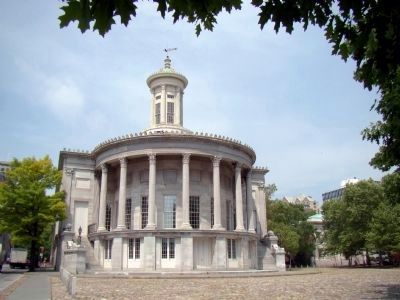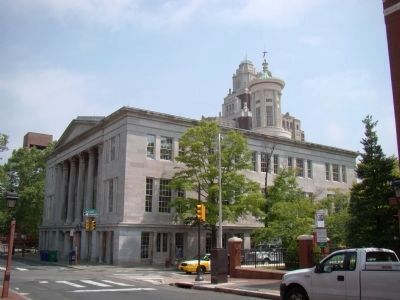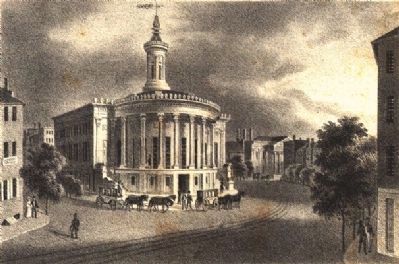Old City in Philadelphia in Philadelphia County, Pennsylvania — The American Northeast (Mid-Atlantic)
Philadelphia Exchange
— Independence Hall National Historical Park —
Inscription.
The magnificent building in front of you testifies to 19th Century Philadelphia’s importance as a financial hub. The Philadelphia (Merchants’) Exchange opened in 1834, and stood in the commercial heart of the city. Merchants, manufacturers, brokers and shipmasters all gathered here to trade stocks and commodities, and to learn the latest business news.
The Exchange has been called architect William Strickland’s “Philadelphia Masterpiece.” Strickland, who broke with British traditions and became a leader in Greek Revival architecture, also designed the Second Bank of the United States on Chestnut Street, and the Tennessee state capitol in Nashville.
The Philadelphia Exchange has been restored on the exterior only. The building is not open to the public.
(sidebar)
“It is indeed a superb classic building, a credit to the skill of its architect, Mr. Strickland, . . . and a lasting monument of the enterprise and liberality of our Merchants, and an ornament to Philadelphia.” —Bricknell’s Counterfeit Detector, 1834.
Erected by Independence National Historical Park. (Marker Number 28.)
Topics. This historical marker is listed in this topic list: Industry & Commerce. A significant historical year for this entry is 1834.
Location. This marker has been replaced by another marker nearby. It was located near 39° 56.848′ N, 75° 8.735′ W. Marker was in Philadelphia, Pennsylvania, in Philadelphia County. It was in Old City. Marker was on Dock Street near Walnut and South 3rd Streets, on the right when traveling north. It was across the cobblestones to the right of the building. Touch for map. Marker was in this post office area: Philadelphia PA 19106, United States of America. Touch for directions.
Other nearby markers. At least 8 other markers are within walking distance of this location. Merchants' Exchange Cupola Restoration (a few steps from this marker); Treasurer's Office Site (within shouting distance of this marker); House Where Lived in 1791 Alexander Hamilton (within shouting distance of this marker); Dr. Benjamin Rush House Site (about 300 feet away, measured in a direct line); Fort Wilson (about 300 feet away); Judge William Lewis (about 300 feet away); First Bank of the United States (about 300 feet away); The City Tavern (about 300 feet away). Touch for a list and map of all markers in Philadelphia.
More about this marker. Marker has an engraving captioned “View of the east side of the Philadelphia (Merchants’) Exchange in 1840” and a portrait of “William Strickland, Architect.”
Marker was removed by National Park Service. It has been replaced by a marker called “Merchants Exchange Cupola Restoration.” This replacement marker has been input into HMDB.
Related markers. Click here for a list of markers that are related to this marker. These are markers at the locations of Merchant Exchanges throughout the years. Today the Philadelphia Exchange is in Center City at 19th and Market Streets.
Also see . . . Philadelphia's Merchants Moved from Coffee House to Tavern to This “Temple of Commerce”. Excerpt: “The Exchange Room in the curved section of the building was remarkable. It had a mosaic floor, domed ceiling supported on marble columns, and frescoes on the walls and ceiling. The fresco painter was Nicola Monachesi who had executed frescoes in many of Philadelphia’s Roman Catholic churches. Real-estate dealing, auctions, and business transactions of all kinds took place in this room, where shipping reports and both local and from all over the world were posted. Inside the building was a post office. further, many marine insurance companies with names like the Delaware No. 3 had offices in the building. Architect Strickland retained an office for himself at the Exchange. Naturally some space was given over to a coffee shop.” (Submitted on January 1, 2012.)
Credits. This page was last revised on February 2, 2023. It was originally submitted on January 1, 2012, by J. J. Prats of Powell, Ohio. This page has been viewed 526 times since then and 8 times this year. Last updated on August 8, 2019. Photos: 1, 2, 3, 4, 5, 6. submitted on January 1, 2012, by J. J. Prats of Powell, Ohio.
